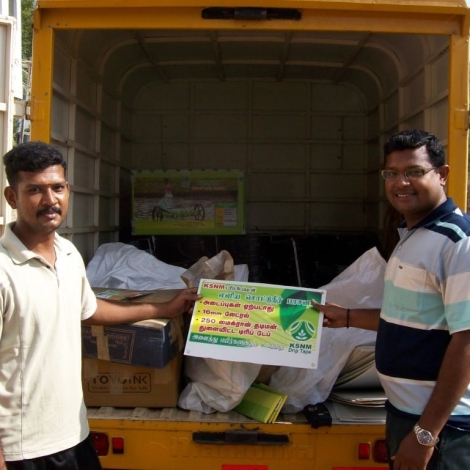One of the biggest challenges in delivering technology to “Bottom of the Pyramid” consumers is the lack of distribution channels that serve this demographic.
We founded MyRain in 2010 as wholesaling social venture to take new technology to small-plot farmers in southern India. We work with non-profits and social ventures from all over the world to help define market demand, overcome local distribution challenges, and deliver transformative value to our customers.
However, MyRain is only a part of the distribution puzzle. If you are preparing to launch products for low income consumers in India, here are some options to explore.
NGOs and Nonprofits
A traditionally popular channel, NGOs and nonprofits have some of the best local connections and are usually very open to experimenting with new products that align with organizational goals. One of the appealing aspects of this channel is that it can reduce or eliminate pricing challenges to the end user, as NGOs may subsidize your product to their base customers and may distribute free of cost.
The primary challenge with this channel is sustainability. Most NGOs are grant-based, with projects and focus shifting as money comes in (often with different use stipulations), making demand difficult to plan. Additionally, NGOs and nonprofits rarely have processes set up to bring in and promote products, so be prepared to customize marketing and logistics for each new partnership.

A MyRain representative helps install irrigation. Photo courtesy of Steele Lorenz
Government programs
Depending on the region you plan to operate in, the government will typically sponsor a number of diverse programs ranging from product subsidies to education. These programs often have strong ties with local communities and are executed through government offices, university outreach programs, and NGOs. Whether through financial support or increased connection with the end user, government assistance could greatly increase the visibility and affordability of your product. Listings can usually be found online at government websites, although information may not be current.
Establishing relations with the government can be a lengthy and costly process that may include requests for bribes. In addition, subsidies can dry up and disappear with changes in leadership, making them difficult to build a sustainable model around.
Retailers
Retailing in India remains largely fragmented. While medium and large format stores are gaining traction in top tier cities, the majority of India is served by small shops selling specific product lines (i.e. hardware, packaged consumables, produce, farm supplies, electronics, etc.). In both urban and rural areas, retailers are usually locally owned, single store establishments. Retailers are set up well for either inexpensive, high-volume goods or expensive, low-volume goods.
Individual retailers can be challenging to contact and sell to. They will need 25-30% margins to be properly incentivized, and may also expect to be supported by local product advertising, which will increase the cost to your end consumer. Try finding a wholesaler for instant access to a base of retailers but plan to add 15-25% to the product cost. Lastly, this is a poor channel if your product requires significant consumer education or behavioral changes, as most shop employees will not have time to share this information.
Banks & micro-finance institutes
In some cases, loan institutions may be interested in creating special financial packages for your products. This approach will require a strong brand presence and proof of repayment in local markets. If you can convince banks to promote your products, you will gain both a financing partner and access to extensive marketing networks.
The key to this channel is to make the bank’s job as easy as possible. Design the loan, provide marketing materials and product training, and show your products’ traction in the market. You will also need a delivery mechanism, as this is only a sales and marketing channel. If you can create an easy template that is profitable for banks and can back it with wide distribution capacity, you have an extremely scalable channel.
Direct sales force
If your product requires installation or significant education or service, you may require your own direct sales force. This approach allows for the most control over brand messaging and customer experience.
Direct is, however, the most expensive and time consuming channel to set up and manage. Hire someone locally with excellent experience and be prepared to make sales and marketing your core organizational focus when pursuing this route.
A good distribution strategy will include several of the channels above. Some channels may be better for different times in your market penetration. For example, NGOs can help in initial education and awareness efforts, whereas banks may provide better marketing support once your brand and product are established. Additionally, channel diversity will make your organization less vulnerable to partner volatility.
Distribution, like most aspects of doing business in India, can be difficult to figure out. The best way to learn about the market is to experiment with many different partners and channels to learn what mix is best for your products. The reward for strong distribution is a larger customer base, greater impact, and a more sustainable operation – well worth the challenge!
Steele Lorenz is Cofounder and CEO of MyRain, a social venture focused on connecting small plot farmers with emerging agricultural technologies.

